This post may contain affiliate links. Please read our disclosure policy.
A basic and easy recipe for homemade pasta dough. With this recipe, you can make lasagne sheets, farfalle, ravioli, tagliatelle, pappardelle and so much more. Making pasta at home is not as hard as it may seem and is so worth the extra effort!
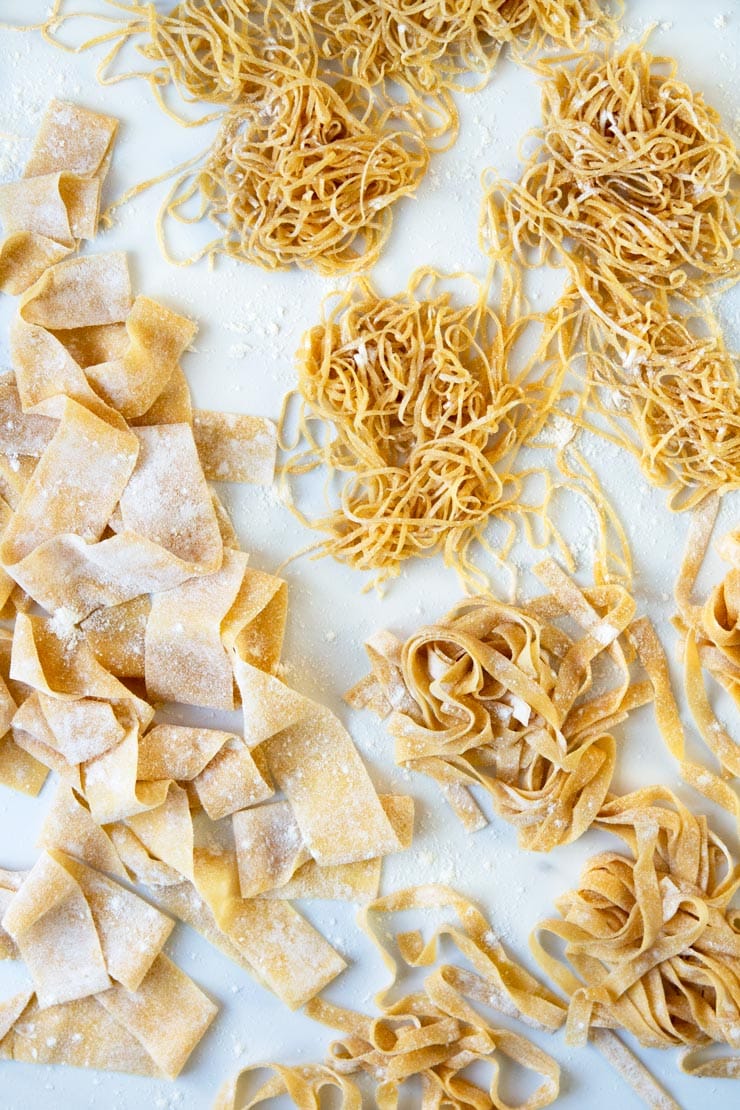
Any Italian food lover loves homemade pasta, whether it’s a rich and comforting lasagne layered with the most delicious meat ragu and silky, creamy bechamel sauce, fresh and delicious orecchiette with broccoli and chilli or pappardelle with earthy mushrooms and speck.
There are SO many variations when it comes to sauces and shapes I could happily eat pasta every day and never, ever get bored!
I don’t think a meal can get any better when it’s made with fresh homemade pasta dough. Not only is the flavour unreal but the texture and pure satisfaction of that first bite of cosy, home cooking is enough to send you straight to food heaven!
This step by step guide to homemade pasta dough will give you a basic recipe that can be made into all sorts of delicious and comforting meals. I’ve created step by step photos for making the pasta dough from scratch and then making into lasagne sheets, tagliatelle, pappardelle and fettuccine although the variations are endless.
Egg To Flour Ratio
The general rule is 1 large egg to every 100g (3.5 oz) of 00′ flour. I like to add 1 extra egg yolk to the whole mixture, please note I do not mean an extra egg yolk to every 100g.
As an example to make ravioli for 6 people I use 3 large eggs, 300g (10.5oz) 00′ flour and 1 egg yolk.
The eggs must be the highest quality free range eggs you can find. In Italy, they have egg specifically for making pasta called ‘Pasta Gialla’ (yellow dough or yellow pasta). The yolks are bright orange giving the pasta a beautiful yellow colour.
Luckily I have found high quality eggs that are free range, delicious and have the perfect yolk to give homemade pasta that perfect colour. Have a search for the best you can find in your area.
P.S the size of the egg matters. If you use small or medium-sized eggs you will need less flour. Stick to large eggs for the best results using this recipe.
Place the flour on a clean work surface, make a well in the middle and add the eggs (photo 1).
Using a fork whisk the eggs whilst slowly incorporating the flour until combined and looks like a very rough dough (photo 2 & 3). You may need to use your hands once most of the egg is incorporated to help it along.
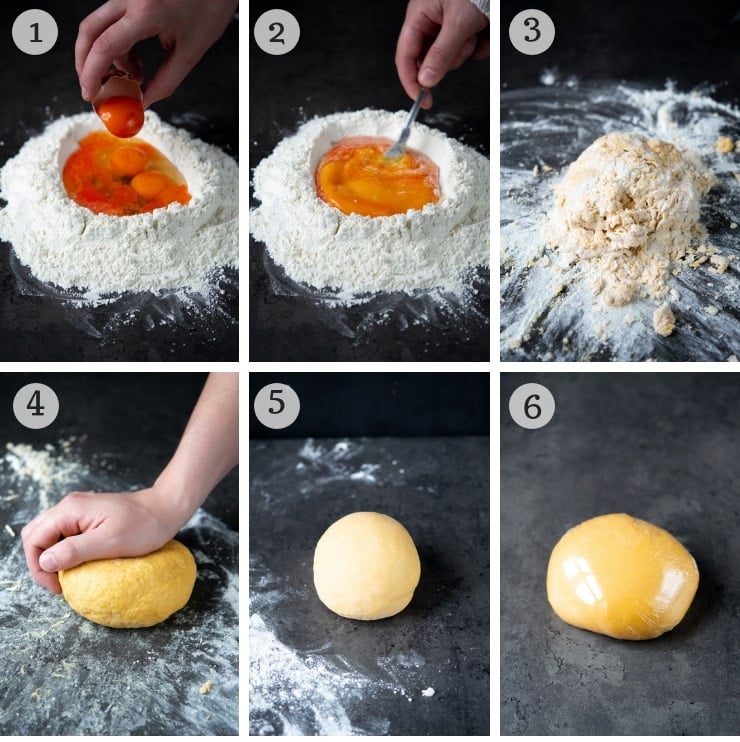
Pin this now to find it later
Pin ItBring the dough together with your hands to form a ball. Knead the dough for 10 minutes until smooth and pliable. Wrap the dough in cling film and leave to rest for 30 minutes, out of the fridge (photos 4-6).
Once the dough is rested it’s time to roll it out. Cut the dough in half so it’s easier to roll out and flatten it with the palm of your hand so it will fit through the first setting on the pasta machine, usually 0 (photos 7 & 8).
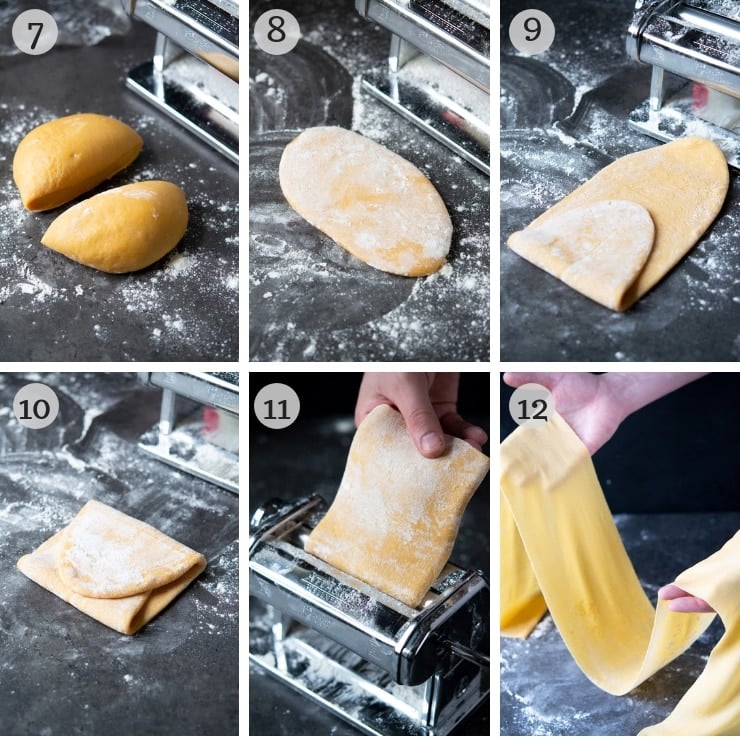
Pass the dough through the widest setting once then fold one side over the other as shown on photos 9 and 10. Flatten the dough with the palm of your hand again so it will fit through the widest setting and roll it through again.
Repeat this process folding the sides in and passing it through the widest setting four times (<< important step do not skip). Once you’ve done that pass the dough through each setting once from the widest to the second last setting (number 8).
The best pasta thickness to choose
I very rarely roll my pasta to the very last setting, I find it a little too thin and much harder to work with because it’s so delicate.
If I’m making ravioli I roll it out to the third last setting, number 7. For lasagne, tagliatelle or pappardelle I roll it out to the second last setting, number 8.
How to make different pasta shapes
Lasagne
Ok so, lasagne sheets are super simple just roll the pasta dough through the machine until you reach the second last setting (my personal preference) or the very last setting. Cut the lasagne sheets to the right size to fit your dish and you’re good to go.
If you’re looking for a classic lasagne recipe made with a rich ragu and silky creamy bechamel sauce check out my lasagne recipe here. I also have a recipe for a vegetarian lentil ragu lasagna and a butternut squash lasagna that’s perfect for fall!
Tagliatelle, pappardelle & fettuccine
Each of the above calls for roughly the same process just different widths. The one exception is that pappardelle (the widest of the three) needs to be cut by hand.
Simply fold your lasagna sheet in half over and over again until you reach a 1-inch width (photos 13 & 14). Cut the roll of pasta into 1/2 inch pieces, you can trim the ends if you need to (photo 15).
Unravel the pappardelle and use as required. If you’re not using straight away shape a few strands at a time into nests to dry out (photo 16).
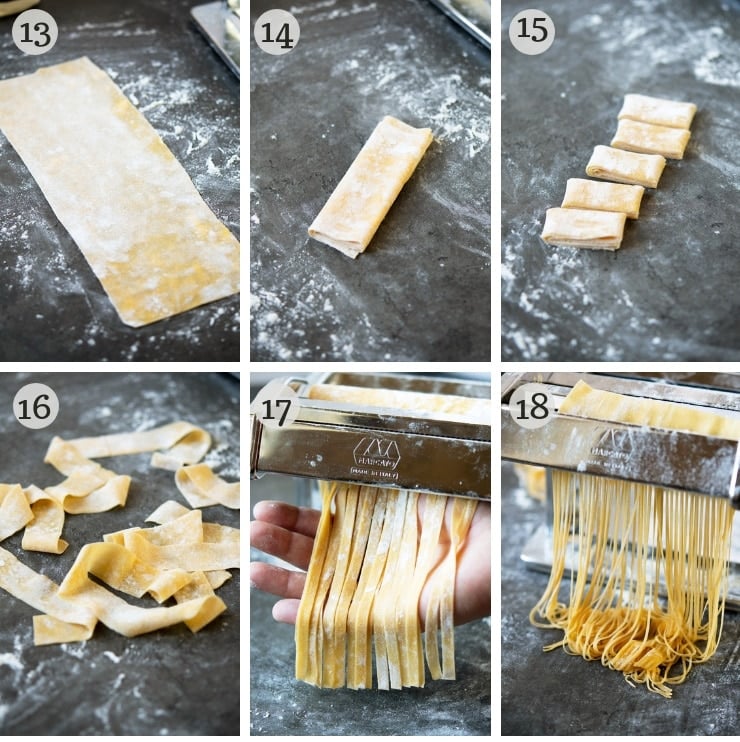
Making tagliatelle and fettuccine are really simple. Place the relevant attachment on your pasta machine (most pasta machines come with this, here’s the one I use). Roll the dough through the machine and you’ll have tagliatelle or fettuccine (photos 17 & 18).
Use the same method and shape the pasta into nests to dry out if you’re not using it straight away.
Top tips
- Use 00′ flour for the best results when making pasta dough from scratch.
- Use the highest quality free range eggs possible.
- Knead the dough for no less than 10 minutes. It should be smooth and elastic in texture. If you’re unsure cut the dough in half, if there are tiny air bubbles inside the dough it’s ready.
- Make sure to rest the pasta dough for 30 minutes before rolling out.
- Make sure to lightly sprinkle flour or semola on your work surface when rolling out.
- Always sprinkle a little flour on the rollers of your pasta machine to stop it sticking.
- Want to make different coloured pasta? Check our super easy Spinach Pasta Dough and Beetroot Pasta Dough recipes.
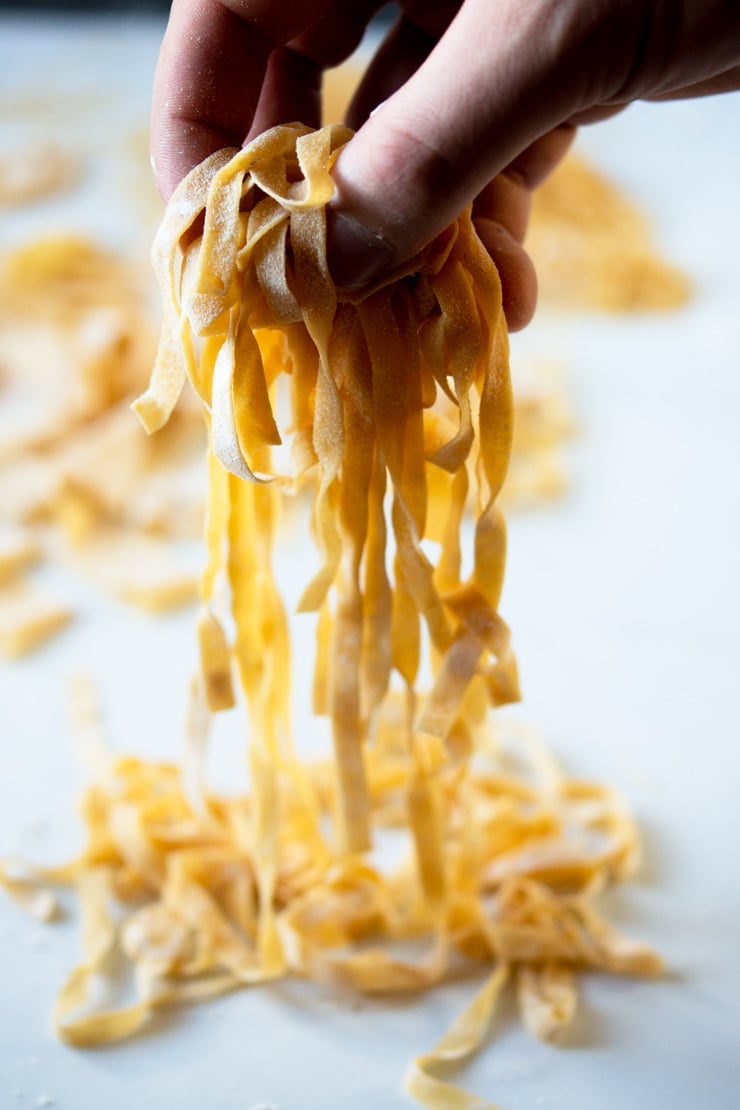
Pasta Sauces To Serve Your Homemade Pasta With
- Artichokes and Peas
- Sun-Dried Tomato & Roasted Red Pepper
- Eggplant Pasta Alla Norma
- Parmesan and Butter
- Easy Sausage Ragu
If you’ve tried this Homemade Pasta Recipe or any other recipe on the blog then don’t forget to rate the recipe and let me know how you got on in the comments below, I love hearing from you! You can also FOLLOW US on FACEBOOK, INSTAGRAM and PINTEREST or sign up to our NEWSLETTER to see more of our delicious food
Step By Step Photos Above
Most of our recipes come with step by step photos, helpful tips and tricks to make it perfectly first time and even video!
Homemade Pasta Dough
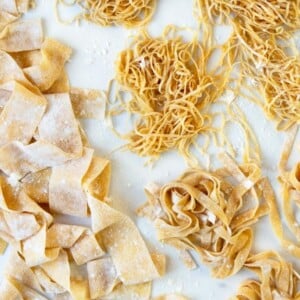
Ingredients
- 400 g 00’ Flour, (3 cups spooned and levelled)
- 4 large eggs, free range
- 1 egg yolk, free range
Instructions
- Place the flour on a clean work surface, make a well in the middle and add the eggs (photo 1).
- Using a fork whisk the eggs whilst slowly incorporating the flour until combined and looks like a very rough dough (photo 2 & 3). You may need to use your hands once most of the egg is incorporated to help it along.
- Bring the dough together with your hands to form a ball. Knead the dough for 10 minutes until smooth and pliable. Wrap the dough in cling film and leave to rest for 30 minutes, out of the fridge (photos 4-6).
- Once the dough is rested it’s time to roll it out. Cut the dough in half so it’s easier to roll out and flatten it with the palm of your hand so it will fit through the first setting on the pasta machine, usually 0 (photos 7 & 8).
- Pass the dough through the widest setting once then fold one side over the other as shown on photos 9 and 10. Flatten the dough with the palm of your hand again so it will fit through the widest setting and roll it through again.
- Repeat this process folding the sides in and passing it through the widest setting four times. Once you’ve done that pass the dough through each setting once from the widest to the second last setting (number 7).
How To Make Lasagne sheets, Tagliatelle, Pappardelle and Fettuccini;
Lasagne
- Ok so, lasagne sheets are super simple just roll the pasta dough through the machine until you reach the second last setting (my personal preference) or the very last setting. Cut the lasagne sheets to the right size to fit your dish and you’re good to go.
- If you’re looking for a classic lasagne recipe made with a rich ragu and silky creamy bechamel sauce check out my lasagne recipe here. I also have a recipe for a vegetarian lentil ragu lasagna and a butternut squash lasagna that’s perfect for fall!
Tagliatelle, Pappardelle & Fettuccine
- Each of the above calls for roughly the same process just different widths. The one exception is that pappardelle (the widest of the three) needs to be cut by hand.
- Simply fold your lasagna sheet in half over and over again until you reach a 1-inch width (photos 13 & 14). Cut the roll of pasta into 1/2 inch pieces, you can trim the ends if you need to (photo 15).
- Unravel the pappardelle and use as required. If you’re not using straight away shape a few strands at a time into nests to dry out (photo 16).
- Making tagliatelle and fettuccine are really simple. Place the relevant attachment on your pasta machine (most pasta machines come with this, here’s the one I use). Roll the dough through the machine and you’ll have tagliatelle or fettuccini (photos 17 & 18).
- Use the same method and shape the pasta into nests to dry out if you’re not using straight away.
Notes
The Best Pasta Thickness To Choose
I very rarely roll my pasta to the very last setting, I find it a little too thin and much harder to work with because it’s so delicate. If I’m making ravioli I roll it out to the third last setting, number 7. For lasagne, tagliatelle or pappardelle I roll it out to the second last setting, number 8.Egg To Flour Ratio
The general rule is 1 large egg to every 100g (3.5 oz) of 00′ flour. I like to add 1 extra egg yolk to the whole mixture, please note I do not mean an extra egg yolk to every 100g. As an example to make ravioli for 4-6 people I use 3 large eggs, 300g (10.5oz) 00′ flour and 1 egg yolk. The eggs must be the highest quality free range eggs you can find. In Italy, they have egg specifically for making pasta called ‘Pasta Gialla’ yellow dough or yellow pasta. The yolks are bright orange giving the pasta a beautiful yellow colour. Luckily I have found high quality eggs that are free range, delicious and have the perfect yolk to give homemade pasta that perfect colour. Have a search for the best you can find in your area. P.S the size of the egg matters. If you use small or medium sized eggs you will need less flour. Stick to large eggs for the best results using this recipe.Extra Tips For Making Homemade Pasta Dough
- Use 00′ flour for the best results when making pasta dough from scratch.
- Use the highest quality free range eggs possible.
- Knead the dough for no less than 10 minutes. It should be smooth and elastic in texture. If you’re unsure cut the dough in half, if there are tiny air bubbles inside the dough it’s ready.
- Make sure to rest the pasta dough for 30 minutes before rolling out.
- Make sure to lightly sprinkle flour on your work surface when rolling out.
- Always sprinkle a little flour on the rollers of your pasta machine to stop it sticking.
Helpful Info for All Recipes
- I always use extra virgin olive oil in all of my recipes unless stated otherwise
- When I use canned or jarred tomatoes of any kind I always use Cirio or Mutti brands for the best results and flavour.
- All vegetables are medium sized unless stated otherwise
- All recipes are tested and developed using a fan (convection) oven
- Find out more about how nutrition is calculated.
- Check out our must have Italian Pantry Staples.
- You can also find all our Essential Kitchen Tools for Italian Cooking.
Nutrition
Nutrition information is automatically calculated, so should only be used as an approximation.
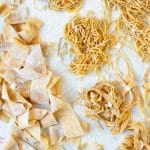
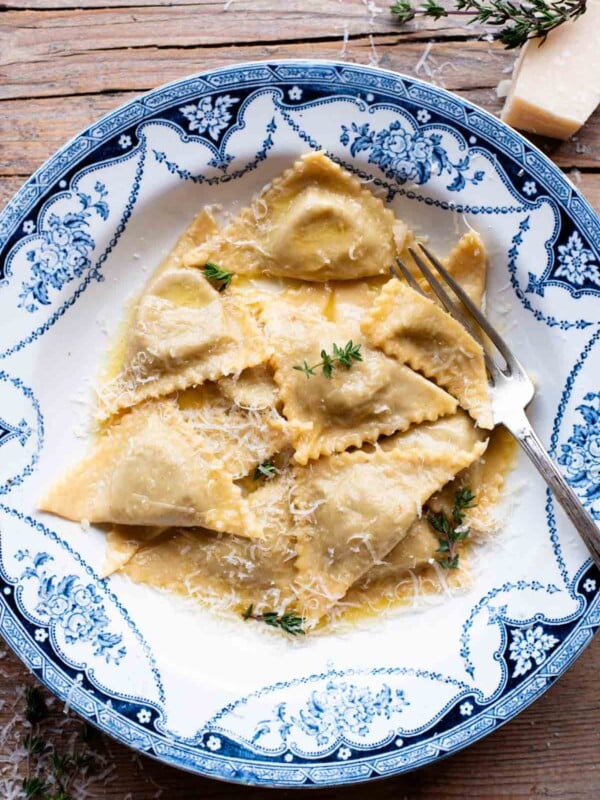
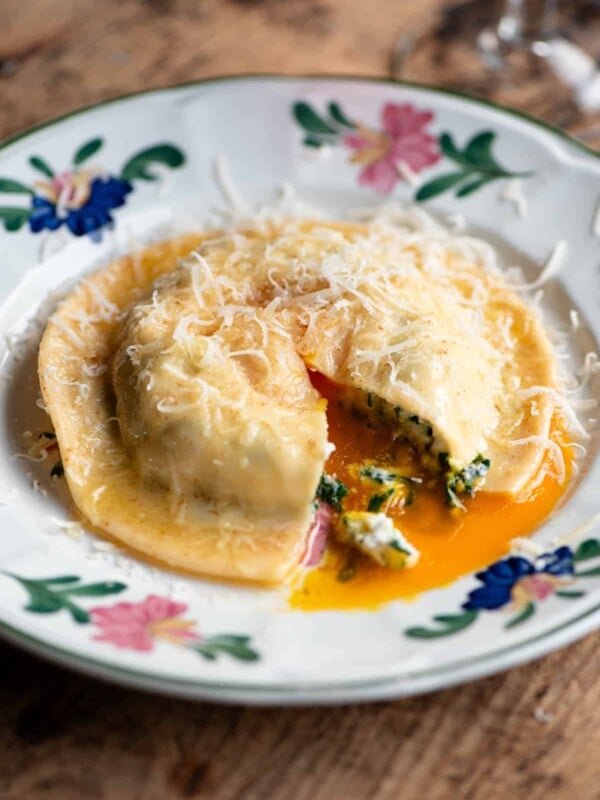











I think it’s important to note that a large egg in the shell is traditionally supposed to weigh a little over 2 ounces (between 59.6. and 63.7 grams). For the last several years, my large eggs have weighed more on the high side of medium. I’ve found myself needing to rely more and more on weight when eggs are a primary ingredient.
*Love* this recipe, which I’ve made a few times but making square ravioli. Can you tell me the diameter of the cutter you’re using for mezzalune?
This recipes ratios make for fantastic fresh pasta! I added a tiny amount of olive oil and have loved the final result every time. I’m still learning to use my kitchenaid stand mixer and attachments, but I yet to be disappointed in flavor.
Made this recipe yesterday, after a disappointing mushroom ravioli while traveling. Needed to scratch that itch. Used regular store eggs, King Arthur flour, don’t know the 00. But followed the recipe. And last night’s mushroom ravioli was freaking amazing.
kneaded 12 minutes, rested 40 minutes. My machine goes from 1-7, so final roll was at 6. Strong simmer for 6 minutes, we were speechless at how wonderful these came out. Used duckfat in the sauce in place of some of the olive oil. We froze half of the ravioli for another night, won’t be long!
What recipe did you use for mushroom ravioli or did you use one (like insidetherustickitchen one for example?)
Some flours are impossible to find in stores. I order off the internet and found Amazon to be a good source. Flour 00 is used in many recipes, all good. I keep all my kitchen ingredients in sealed containers to ensure no contaminants.
Try it.
I use the Italian 00 flour available and it goes a long way to augment the price.
This recipe is the BOMB! silky, smooth dough with an exquisite texture. I used it to make shrimp ravioli and it was heavenly. Thank you!!
Sara
Hello!
Can I use duck eggs instead of chicken to make pasta? I have more duck eggs than I know what to do with them. Thanks!
Hi Anna, yes, you can use duck eggs, they’ll make a beautiful rich dough. Since duck eggs are larger you may only need 3 instead of 4 for our recipe. Let me know how it goes, Emily.
I’ve tried several pasta dough recipes, and this one is by far the best! Supple, silky, and very easy to work with.
Thank you so much, so happy you enjoyed it!
Can you use a stand mixer with a dough hook to make the pasta? If so, how long is the dough kneaded with the machine?
Hi Francine, yes you can use a dough hook in a stand mixer. Knead it for about 5-10 minutes, to check it’s ready you can cut the dough in half to make sure there are small air bubbles inside and it should be smooth and elastic. Lightly push your finger into the dough and it should spring back, if not it needs longer.
With a KitchenAid pasta roller (where settings to from 1 to 8), I roll to #6. Should I actually roll to #7? I’ve worried about going too thin in case the dough comes apart while cooking.
Hi Janice, you’ll probably be ok sticking with number 6, you want it to have a bite to it and not be paper thin. You could always try a small piece of dough at number 7 and see how it goes?
Can the dough be made the day before and rolled out the next day? I love making your mushroom raviolis (absolute favourite!). But it is a bit time consuming. I want to make it for guests but with a baby it’s hard to be able to make it all at once (the filling I prepare day before).
Thanks!
Hi Jesse, yes, you can make the pasta dough the day before and keep it in the fridge, the colour of it may darken slightly but it’s still absolutely fine to use. The other option is to make the filled ravioli and blanch them in boiling water until they float to the top. Let them dry completely on a kitchen towel (don’t let them touch each other or they’ll stick) then store them in the fridge. The blanching stops the ravioli from going soggy once filled.